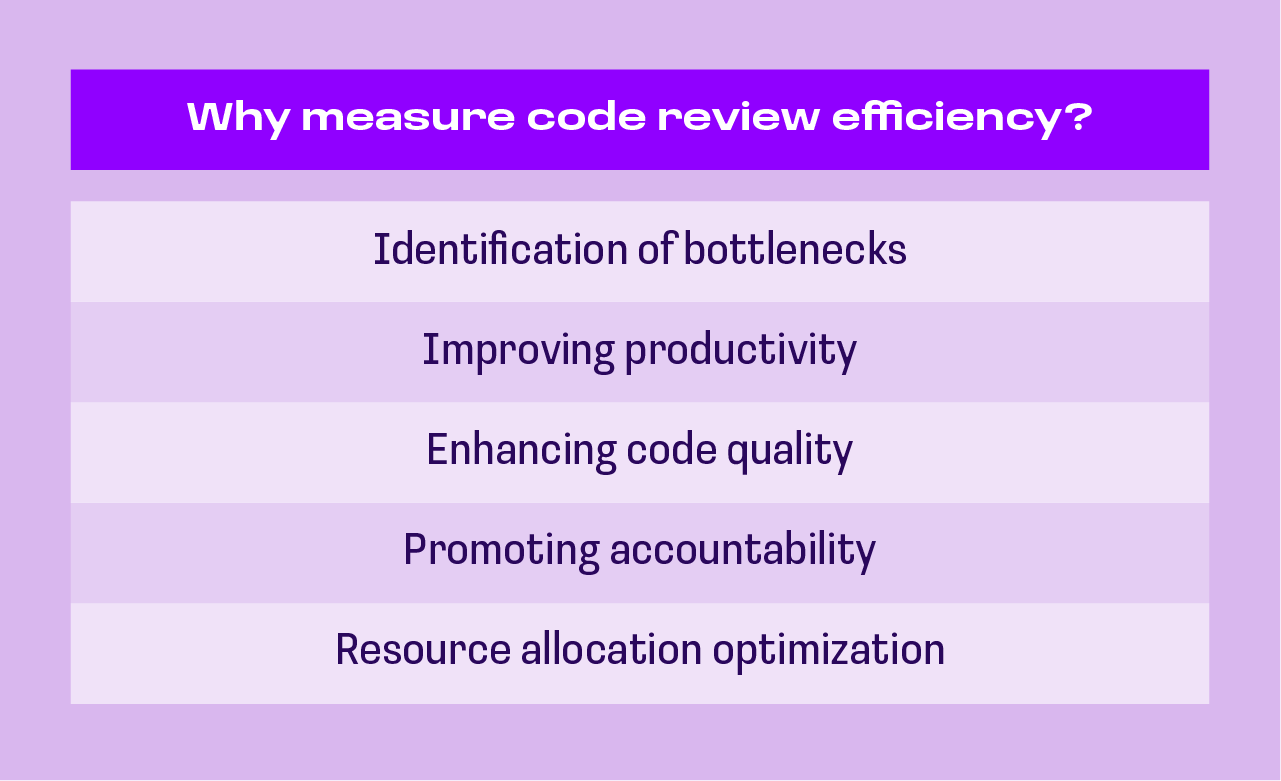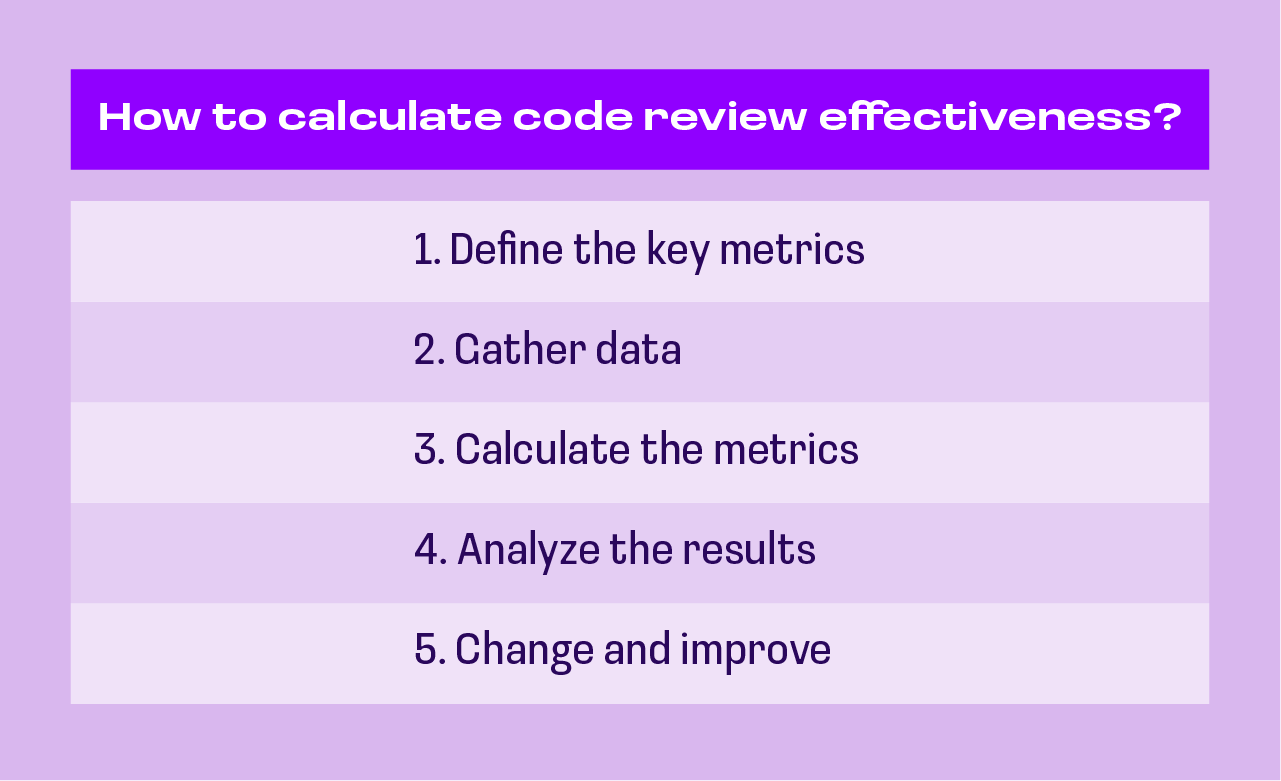How to calculate code review effectiveness
The author of this article is tech expert Pieter Murphy. Invited experts — Senior Project Manager Aleksandr Gushchin and one of the co-authors of the Code Review course Project Manager Alexey Shcheglov.

In a professional context, code review effectiveness emphasizes the necessity of peer validation to ensure adherence to coding standards and quality benchmarks.
Tracking and analyzing the duration and quality of code reviews can provide insights into process efficiencies and areas for improvement.
Understanding code review efficiency is crucial for optimizing development workflows and ensuring high standards of software quality.
Without further ado, let’s dive in, with the help of Senior Project Manager, EngX expert Aleksandr Gushchin and the co-author of the EngX Code Review course Alexey Shcheglov, to find out more.
What is code review efficiency?
I asked Aleksandr Gushchin to help us get started with a code review efficiency definition. Here’s what he said:
“Efficient code review integrates prompt and constructive feedback, thorough examination, and team collaboration, reinforced by robust tools. Ongoing evaluation is key to sustaining and improving this efficiency. Such a strategy not only detects issues early but also fosters ongoing enhancement in code quality and team synergy.”
Often, the process encompasses factors that include:
- Timeliness
- Thoroughness
- Clear objectives
- Constructive feedback
- Collaboration and communication
- Automation
- Learning opportunities
- Documentation
By optimizing these facets, software development teams can improve efficiency, deliver higher-quality code, and foster a culture of collaboration and continuous improvement, aligning with DevOps and Agile methodologies.
Why measure code review efficiency?
As implied by what code reviews accomplish, measuring code review efficiency is a great way to determine how to improve it. Aleksandr Gushchin sums it up this way:
“Measuring code review efficiency is essential for understanding its impact on code health, cost, and duration. It also enhances collaboration, reduces risks, and enables data-driven decision-making, promoting agility and process improvements.”
Here are some other reasons why you may want to measure code review effectiveness.
- Identification of bottlenecks. Tracking metrics related to code review, such as turnaround times and review-to-change ratios, can help identify bottlenecks in the development process and inform proactive steps to improve efficiency.
- Improving productivity. Tracking code review metrics allows developers to improve performance by reducing time without sacrificing quality and following proven best practices.
- Enhancing code quality. Effective code reviews are intended to improve quality. By tracking their efficiency, you can ensure that teams assess the effectiveness of the process to catch issues early and prevent them from reaching production.
- Promoting accountability. Metrics help hold team members accountable for their contributions to the review process. They give visibility into participants and the length of reviews and show whether they are conducted according to guidelines.
- Resource allocation optimization. Measuring code review efficiency provides insights into process bottlenecks, productivity improvements, code quality enhancement, accountability promotion, and resource allocation optimization, all of which are crucial for a robust development lifecycle.

Overall, measuring efficiency is essential for driving code quality, team collaboration, and productivity improvements while providing valuable insights into the review process. It is also a great way to make data-driven decisions for development lifecycle optimization.
Metrics for measuring code review effectiveness
To bring the process into focus, it is worth exploring the main metrics developers track to figure out their level of code review efficiency. Aleksandr Gushchin helped me run down the main points. Here is what he had to say:
“Essential metrics for measuring code review effectiveness include failure rate, code review cycle time, post-review pipeline failures, and reviewer participation rates. These metrics provide a comprehensive view of the review process and help identify areas for improvement:
- Failure rate (or percentage of feedbacks) - it should be under control to make a decision if new steps/standards/trainings/tools are needed to minimize team misalignment. It could be additional analysis of negative feedback reasons to decide if something should be changed. For example, training, documentation, extended rules to Sonar, changes to commit message template, new tools like SAST etc.
- Code review cycle time - how long it takes code is ready for review until review is completed. The shorter the better.
- Analysis of Fails found in pipeline after code review, which could be found on Code review.
- How many developers do code review out of total number of developers.”
Additional metrics include review quality, reviewer efficiency, and code churn, which help evaluate the impact of reviews on code quality, reviewer productivity, and code stability.
- Review quality. This metric tracks the effectiveness of reviews in improving code quality and mitigating bugs. It includes metrics like the percentage of issues found during reviews that are addressed before merging (review-to-change ratio), the rate of post-release bugs for reviewed code, and the impact of reviews on code maintainability and reliability.
- Reviewer efficiency. This metric measures the productivity and effectiveness of individual reviewers. It focuses on stats like the amount of code review completed per unit of time, the ratio of comments provided to lines of code reviewed, and the average time spent per review. Higher efficiency rates higher productivity and contributions to the process.
- Code churn. Code churn measures the frequency and extent of code changes in response to review feedback. It tracks metrics like the number of changes made to code, the percentage of code iterations after reviews, and the impact of code churn on development timelines and code stability. Generally, the goal is to keep code churn low.
These performance metrics can be monitored using tools like GitHub, GitLab, CodeGuru, or BitBucket.
Factors that affect code review efficiency
Challenges affecting code review efficiency include time and cost constraints, team size and expertise, codebase complexity, tooling and automation, and communication quality. Addressing these factors is critical for maintaining an effective review process:
- Time and cost. Reviewing code takes time and is not free. It requires you to deploy developers to review and provide feedback on their peers’ code. Code reviews can prove challenging to implement for an organization pressed for time or short on funding.
- Team size and composition. How big is your team, and how skilled are they at code review? Larger teams could find it challenging to coordinate reviews and return feedback on time, while smaller teams could run into resource bottlenecks. Additionally, the expertise level can affect the quality and effectiveness of reviews.
- Codebase complexity. The complexity of the code under review can impact the efficiency of the review process. Highly complex codebases could take more time to analyze and review thoroughly. The same challenges could be faced when reviewing poorly structured code, lacking documentation, or being too verbose.
- Tooling and automation. Integrated development environments, code review tools, static analysis tools, and automated testing frameworks can help automate repetitive tasks, identify issues, and streamline reviews. Investing in comprehensive tools can improve efficiency, add value to the code, and reduce manual efforts and associated pitfalls.
- Communication and feedback. Clear and effective communication can help move code reviews along faster. Reviewers and authors should have clearly defined lines of communication to provide feedback and address concerns quickly. Encouraging open dialogue helps with seeking clarification and providing actionable feedback.
Tailored solutions for overcoming specific code review challenges, such as lack of coding standards and task interruptions, are essential for enhancing review efficiency. Alexey Shcheglov's course provides practical strategies and best practices to address these issues effectively.
He said, “We mention 6 challenges of code review such as absense of coding standards and disturbance from other tasks. For each challenge we provide some tips or solutionssilutions how to overcome the problems.”
How to calculate code review effectiveness?
Calculating code review effectiveness involves defining key metrics, gathering data, calculating metrics, analyzing results, and implementing improvements. This systematic approach allows for continuous optimization and enhancement of the review process:
- Define the key metrics. What are the most important metrics you can measure for your project? They could be turnaround time, review depth, reviewer efficiency, code churn, etc.
- Gather data. Collect data on the metrics you chose using code review tools, version control systems, issue tracking systems, or other sources.
- Calculate the metrics. Using the data collected, calculate how each metric performs based on your collected data.
- Analyze the results. Analyze the metrics to assess the efficiency of your code review process. Spot where patterns, trends, and areas for improvement emerge.
- Change and improve. Analyzing your metrics can provide insights into opportunities to optimize and improve the code review process. Experiment with different changes and track how they impact efficiency over time.

While there is no single code review efficiency formula to calculate code review efficiency, tracking multiple metrics allows an organization to understand how effectively code reviews are conducted within the team.
The best methods to increase code review efficiency with courses from EngX
The EngX Code Review course on Anywhere Club covers essential topics, including self-evaluation, process knowledge expansion, practical application, and dissemination of benefits to team members and stakeholders. These focus areas are designed to enhance code review efficiency:
- It teaches you to self-evaluate your code review skills and pinpoint where to improve.
- It expands your knowledge of the code review process.
- It shows you how to apply the knowledge acquired in practical scenarios.
- It seeks to spread the benefits of your learning to your team and stakeholders.
Access all our other EngX courses to expand your knowledge on key topics, which is empowering, especially when you’re the lead on a project.
Questions for the expert
At the conclusion of our conversation on the topic, I needed help with answering some frequently asked questions about the course. Alexey was happy to answer.
Are there any case studies or real-world examples in the course that illustrate the improvement of code review effectiveness over time?
“Providing near-real-world scenarios helps learners understand the practical benefits and applications of effective code review processes, even in the absence of actual case studies.”
How do you address the challenges of implementing the metrics and strategies for code review effectiveness in diverse development environments?
“The course addresses implementation challenges through dedicated lessons on strategy preparation, metrics application, and scenario-based learning, providing theoretical knowledge and best practices for diverse development environments.”
In your experience, how important is the role of code review tools in enhancing the effectiveness of code reviews, and how is this covered in your course?
“Code review tools are essential for an effective review process. The course covers various tools for automation and quality control, explaining how they integrate to enhance code review efficiency and outcomes.”
Want to know more about Code Review best practices? Watch this video.


.png)
